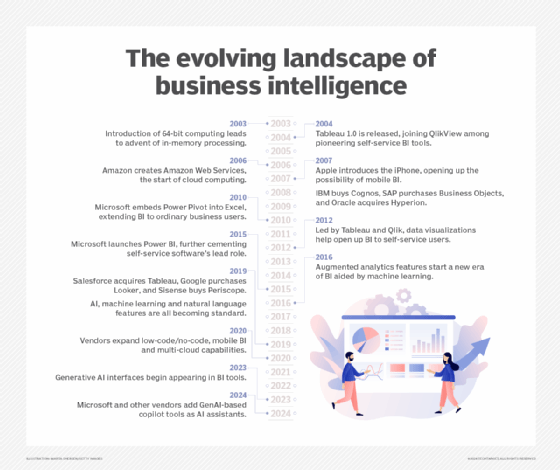
What is real-time business intelligence (RTBI)?
Real-time business intelligence (RTBI) combines data analytics and various data processing tools to enable access to the most relevant, up-to-the-minute data and visualizations. RTBI leverages smart data storage systems such as real-time data warehouses and business intelligence systems to help organizations make smarter decisions.
Data virtualization, data federation, enterprise information integration, enterprise application integration and service-oriented architectures are technologies that enable RTBI. Complex event processing tools analyze data streams in real time, and either trigger automated actions or alert users to patterns and trends. Other real-time BI tools include cloud-based key performance indicator (KPI) dashboards that serve up real-time data-driven decision support and business operations process monitoring analytics at a glance, as well as mobile apps that present them.
To maximize real-time BI tools, organizations need a strong infrastructure built to store and process data optimized for analytics. They must also have processes in place to help understand the value of their data, and a strategy to collect and analyze the most suitable data types. Strategies might involve building and using a data lake, data warehouse or data mart, or even a combination of these, depending on business needs.
How does RTBI differ from traditional BI?
RTBI gives organizations a real-time view of their operations, enabling them to quickly make business decisions. Traditional BI relies on historical data and periodic reports, which limit an organization's ability to respond quickly to changing situations.
This article is part of
What is business intelligence (BI)? A detailed guide
What are the benefits of real-time business intelligence?
RTBI tools come with several benefits that are helpful, out of the box, for different industry verticals. These benefits include the following:
- Instant decision-making. RTBI supports instant decision-making, which is necessary, for example, if a company sells clothing online. The company's website and representatives at the company's call center must have the same up-to-the-minute data regarding inventory levels. If a customer places an order and a particular size or color is sold out, the customer can be notified and redirected to another, similar item.
- Competitive advantage. As consumer expectations grow higher each day, making intelligent decisions based on real-time data is increasingly critical to business relevance. RTBI provides the information organizations need, including forecast analysis and trend analysis, to make tactical decisions that help them take advantage of events as they occur. By using enterprise data to improve customer engagement, productivity and efficiency, businesses can gain competitive advantage and increase revenue.
- Rapid detection of critical issues. RTBI isn't just about improving the bottom line. Businesses can also use it as a service intelligence tool to optimize maintenance protocols and prevent potential downtime.
Given the many uses and benefits of RTBI, it's wise to apply a multipronged approach. Some other RTBI application areas include the following:
- Application performance monitoring.
- Customer relationship management.
- Data security monitoring.
- Data validation.
- Demand sensing.
- Dynamic pricing and yield management.
- Fraud detection.
- Operational intelligence and risk management.
- Systems monitoring.

RTBI in supply chain analytics
RTBI can help supply chain managers and staff generate reports as well as personalized dashboards and alerts to monitor performance against objective goals and KPIs for supply chain management. With RTBI tools, users can quickly find solutions to problems, test hypotheses by analyzing patterns and trends in the data, and prepare for future demands while averting disruptions.
However, real-time data analytics with BI isn't required for every part of a company's operations. Most BI users can meet their business goals by looking at weekly or monthly performance numbers and long-term trends such as year-over-year comparisons. Similarly, finance groups might not need real-time data to analyze financial metrics or compare actual budgets to forecasts.
Because RTBI implementations can increase the overall cost of a BI system, the best practice for organizations is to deploy real-time BI technology only when it's absolutely required.
Examples of real-time business intelligence
RTBI has proliferated swiftly in recent years, owing to rapid advances in both analytical methodology and IT architectures and apps that support it, as well as the competitive edge it can bestow. RTBI has become a mission-critical asset of the enterprise.
Examples of this proliferation abound. They can be found in almost every industry and vertical -- from logistics to marketing to sales, from healthcare to manufacturing to finance. The following are some additional specific uses of RTBI:
- Equipment failure detection or prediction.
- Supply chain optimization.
- Call center optimization.
- Dynamic workflow adaptation.
The following are some real-world applications:
- Netflix and its peers use RTBI for targeted content promotions.
- Uber offers dynamic pricing, driven by real-time assessment of driving conditions, driver availability and demand surge.
- Lowe's uses manifest shipment planning by store, based on dynamic sales data.
- Starbucks' purchase prediction system and marketing is based on individual customer preferences.
- Walmart uses RTBI for online behavioral analysis to interpret customer purchasing patterns.
- Delta Air Lines uses RTBI to monitor its baggage handling to gather data for root cause analysis of baggage mishaps.
Learn how data warehouses and data marts compare and how each plays a key role in the BI and analytics process.






